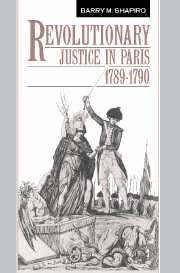Book contents
- Frontmatter
- Contents
- Preface
- Acknowledgments
- List of abbreviations
- Introduction
- 1 Revolutionary justice in 1789–1790: the Comité des Recherches, the Châtelet, and the Fayettist coalition
- 2 The judicial aftermath of the July Revolution
- 3 The Besenval affair: amnesty or prosecution?
- 4 Lafayette, Orléans, and the October Days
- 5 The post-October Days campaign against the left
- 6 The Favras conspiracy
- 7 The Favras–Besenval judicial transaction
- 8 The Maillebois conspiracy
- 9 The October Days affair and the radicalization of the Comité des Recherches
- 10 The Maillebois and October Days affairs: mutual amnesty and the breakup of the Fayettist coalition
- Conclusion
- Notes
- Select bibliography
- Index
3 - The Besenval affair: amnesty or prosecution?
Published online by Cambridge University Press: 16 October 2009
- Frontmatter
- Contents
- Preface
- Acknowledgments
- List of abbreviations
- Introduction
- 1 Revolutionary justice in 1789–1790: the Comité des Recherches, the Châtelet, and the Fayettist coalition
- 2 The judicial aftermath of the July Revolution
- 3 The Besenval affair: amnesty or prosecution?
- 4 Lafayette, Orléans, and the October Days
- 5 The post-October Days campaign against the left
- 6 The Favras conspiracy
- 7 The Favras–Besenval judicial transaction
- 8 The Maillebois conspiracy
- 9 The October Days affair and the radicalization of the Comité des Recherches
- 10 The Maillebois and October Days affairs: mutual amnesty and the breakup of the Fayettist coalition
- Conclusion
- Notes
- Select bibliography
- Index
Summary
Having withdrawn from Paris with most of his troops on the evening of July 12, the Baron de Besenval had returned to Versailles where he found himself besieged by rumors that he would be arrested or assassinated. Yet, his self-described devotion to duty and the royal family was so great that he only agreed to flee when Louis XVI “ordered” him to do so. But once the decision to try to escape was made, attention needed to be given to the problem of eluding the revolutionary “chasseurs”:
The entire kingdom being in arms, with all outlets closed, it was doubtful I could go far without being arrested. Suggestions were made that I disguise myself and I rebuffed them impatiently. But they kept hounding me. Finally, I agreed to dress myself as a gendarme. The Prévôt-Général gave me two cavaliers as an escort, and I left Versailles at dusk.
The problem with this account, however, is that it doesn't explain why one of the French army's highest ranking officers was left to flee the country without the kind of military protection made available to many of the other fugitives. Broglie, Lambesc, and many of the other top military leaders had gone to Saint-Denis (where most of the troops had been sent after July 14) and had then left for the eastern frontier. Why didn't Besenval go there? Or why wasn't he furnished with a more substantial escort of his own?
- Type
- Chapter
- Information
- Revolutionary Justice in Paris, 1789–1790 , pp. 59 - 83Publisher: Cambridge University PressPrint publication year: 1993

